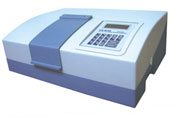| Laboratory Equipments >> Spectrophotometers >> Double Beam UV-VIS Spectrophotometers |
|||||||||||||||||||||||||||||||||||||||
 Double Beam UV-VIS Spectrophotometers |
|||||||||||||||||||||||||||||||||||||||
Double Beam UV-VIS Spectrophotometers Specifications Parameter
Photometric
Data Presentation
Sample Attachment
|
Salient Features and Benefits
- Smallest form factor double beam spectrophotometer with a high-resolution bandwidth
- Stand alone unit offers an advanced technology with data processing features for scanning discrete wavelength, concentration determination by standards and cofactor method, time scan with minimum time interval of 1.0 sec, auto-zero facility, self check and self diagnostic modes
- Comes with automatic wavelength calibration, programmable wavelength for lamp change over
- Menu driven microprocessor based software makes the stand alone unit user friendly.
- PC compatible through USB
- Software is 21 CFR Part 11 compliant with password method protection; Instrument Log Book etc, cGLP compliance is addressed.
- This Instrument finds place for any spectrophotometric or colorimetric measurement where applications require very high-resolution bandwidth and cGLP compliance is mandatory.
- Micronutrients like N, P, K, S, Ca, Mg, Zn, Cu, B, Mo, etc., in Agricultural soil, Plants etc.
- Glucose, Fructose, Carbohydrates, Proteins etc., in Foods.
- Edible dyes, alcohols etc., in beverages
- Purity of constituents in pharmaceuticals
- Toxic elements like Cadmium, Lead, Mercury, Arsenic and Mercury etc., in Effluents.
- Constituents in compositions used in Metallurgy, Fertilizer, Pesticide, Chemical, Petro Chemical, Steel, Cement, Glass & Other Industries.
- Life science applications

